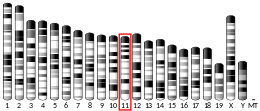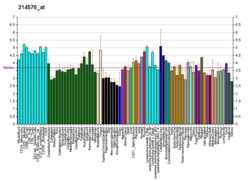
Keratin, type I cytoskeletal 4 also known as cytokeratin-4 (CK-4) or keratin-4 (K4) is a protein that in humans is encoded by the KRT4 gene.

Keratin, type I cytoskeletal 10 also known as cytokeratin-10 (CK-10) or keratin-10 (K10) is a protein that in humans is encoded by the KRT10 gene. Keratin 10 is a type I keratin.

Keratin 9 is a protein that in humans is encoded by the KRT9 gene.

Keratin, type I cytoskeletal 19 (Keratin-19)) also known as cytokeratin-19 (CK-19) is a 40 kDa protein that in humans is encoded by the KRT19 gene. Keratin-19 is a type I keratin.

Keratin 18 is a type I cytokeratin. It is, together with its filament partner keratin 8, perhaps the most commonly found products of the intermediate filament gene family. They are expressed in single layer epithelial tissues of the body. Mutations in this gene have been linked to cryptogenic cirrhosis. Two transcript variants encoding the same protein have been found for this gene.

Keratin 16 is a protein that in humans is encoded by the KRT16 gene.

Keratin, type II cytoskeletal 8 also known as cytokeratin-8 (CK-8) or keratin-8 (K8) is a keratin protein that is encoded in humans by the KRT8 gene. It is often paired with keratin 18.

Envoplakin is a protein that in humans is encoded by the EVPL gene.

Keratin, type II cuticular Hb1 is a protein that in humans is encoded by the KRT81 gene.

Keratin, type I cuticular Ha1 is a protein that in humans is encoded by the KRT31 gene.

Keratin, type II cuticular Hb6 is a protein that in humans is encoded by the KRT86 gene.

Keratin, type II cytoskeletal 78 is a protein that in humans is encoded by the KRT78 gene.

Keratin, type I cuticular Ha3-II is a protein that in humans is encoded by the KRT33B gene.

Keratin, type I cytoskeletal 23 is a protein that in humans is encoded by the KRT23 gene.

Keratin, type I cuticular Ha2 is a protein that in humans is encoded by the KRT32 gene.

Keratin, type I cuticular Ha3-I is a protein that in humans is encoded by the KRT33A gene.

Keratin, type I cuticular Ha4 is a protein that in humans is encoded by the KRT34 gene.

Keratin, type II cuticular Hb5 is a protein that in humans is encoded by the KRT85 gene.

Keratin 83, also known as KRT83, is a protein which humans is encoded by the KRT83 gene.

Keratin 80, also known as KRT80, is a protein which humans is encoded by the KRT80 gene.






